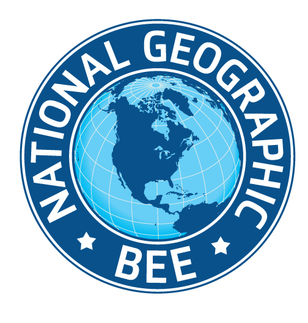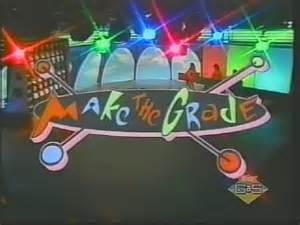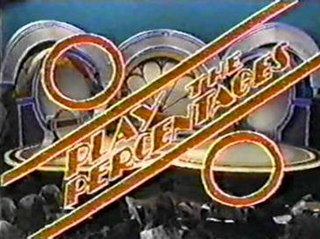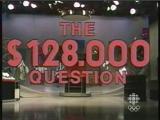
The $64,000 Question was an American game show broadcast in primetime on CBS-TV from 1955 to 1958, which became embroiled in the 1950s quiz show scandals. Contestants answered general knowledge questions, earning money which doubled as the questions became more difficult. The final question had a top prize of $64,000, hence the "$64,000 Question" in the show's title.

The National Geographic GeoBee was an annual geography contest sponsored by the National Geographic Society. The bee, held annually from 1989 to 2019, was open to students in the fourth through eighth grades in participating schools from the United States.

SmartAsk is a Canadian quiz show which ran for three seasons on CBC Television. The show was taped in front of a live audience, with the players sitting on a tiered set. The SmartAsk tournament was described by Ralph Benmergui, the show's executive producer, on TSN's Off The Record as being "Reach for the Top on acid," although in practice this largely involved crude humour, especially as the show went on and ratings sagged.
The Joker's Wild is an American television game show that aired at different times between 1972 and 2019. In the show, contestants answer questions based on categories determined randomly by a mechanism resembling a slot machine. The show's title refers to the game's slot-machine mechanism also having jokers.

Now You See It is an American television game show created by Frank Wayne for Mark Goodson-Bill Todman Productions. The object of Now You See It is to answer general knowledge trivia questions by finding the answers hidden in a grid, similar to a word search puzzle.

Jackpot is an American and Canadian television game show produced by Bob Stewart which saw contestants attempting to solve riddles in order to win cash and prizes.

Make the Grade is a children's game show that aired from October 2, 1989, to September 14, 1990, on Nickelodeon.

Stump the Schwab is an American game show that aired on ESPN2 and ESPN Classic from July 8, 2004 to September 29, 2006. The show featured three contestants trying to defeat Howie Schwab, ESPN's first statistician, in a sports trivia contest. Stuart Scott was the show's host. The show also appeared on Canada's The Score Television Network.
Trump Card is an American syndicated game show that aired from September 10, 1990, to May 24, 1991, hosted by Jimmy Cefalo. Debi Massey served as hostess and Chuck Riley was the announcer. The show was produced by Telepictures Productions, Createl, Ltd., and Fiedler-Berlin Productions, with Warner Bros. Television distributing. It was based on the British game show Bob's Full House, which consisted of contestants trying to answer questions to fill up a 15-square bingo board.

Dream House is an American game show that saw contestants competing to win, as the title of the show indicates, a new house. The show originally premiered in primetime on ABC on March 27, 1968, with a daytime edition premiering on April 1, 1968. The primetime series aired weekly until September 19, 1968, and the daytime series aired daily until January 2, 1970, when it was replaced with All My Children. The daytime series was revived for NBC's daytime schedule and premiered on April 4, 1983, running until June 29, 1984.

Play the Percentages is an American game show hosted by Geoff Edwards which aired in syndication from January 7 to September 12, 1980. Jay Stewart announced for the first six weeks, after which Bob Hilton became the permanent announcer.

Split Second is an American game show that was created by Monty Hall and Stefan Hatos and produced by their production company, Stefan Hatos-Monty Hall Productions.
Fandango is a country music-themed quiz show which aired on The Nashville Network from March 8, 1983 to August 26, 1988, with reruns airing through March 31, 1989, when it was replaced by Top Card. Fandango was the first TV game show to air on TNN and was one of the longest-running game shows on a cable network.
Counterpoint is a BBC Radio 4 quiz. Described in the show's introduction as "The general knowledge music quiz", the questions are about music, from classical, jazz, pop, musicals, and all other forms of music. It was originally hosted by Ned Sherrin (1986–2006). In the chair for the 2007 series was Edward Seckerson with Paul Gambaccini taking over in 2008, following the death of Ned Sherrin in 2007. Russell Davies took over temporarily in 2013 following allegations made against Gambaccini, who returned to the show in November 2014 after being cleared of the allegations.
You Bet Your Ass is a Canadian game show that aired on The Comedy Network. It followed a blackjack and casino motif, with contestants answering questions on popular culture to earn points. The contestant with the most points at the end of the show was the winner.
Lucky Numbers was a weekly Bingo-based game show that aired on ITV from 9 January 1995 to 4 July 1997 and was hosted by Shane Richie.
Turn It Up! is a musical game show that aired on MTV from June 30 to December 7, 1990. It was the second game show to be produced and broadcast on the network after Remote Control, produced by Albie Hecht, Alan Goodman, and Fred Seibert, of Chauncey Street Productions in New York City.
Scream! If You Know the Answer is a British game show presented by Duncan James and narrated by Colin Murray. The games are simple general knowledge, but they are played on the rides at theme park Thorpe Park. Contestants consist of two teams of two, one member of each team being a celebrity.
Jeopardy! is an American television game show created by Merv Griffin. The show is a quiz competition that reverses the traditional question-and-answer format of many quiz shows. Rather than being given questions, contestants are instead given general knowledge clues in the form of answers and they must identify the person, place, thing, or idea that the clue describes, phrasing each response in the form of a question.
Cleverdicks was a British television quiz show for Sky Atlantic, hosted by Ann Widdecombe. Running for 30 episodes, it was later repeated on Challenge. Four contestants competed in each episode for the right to call themselves "cleverdicks" and play for a roll-over cash jackpot. As explained by Widdecombe at the beginning of the first episode, a cleverdick is a person who is "irritatingly and ostentatiously knowledgeable or intelligent." The question material was therefore primarily academic in nature.










